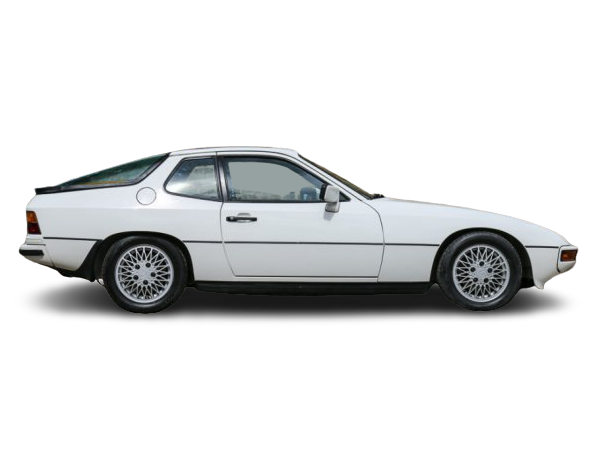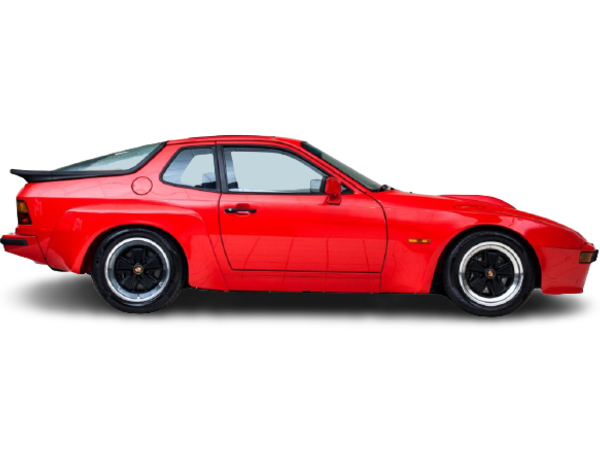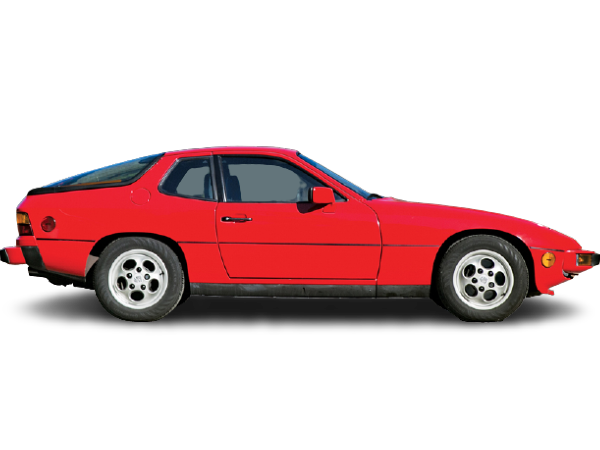The Porsche 924 Story
The need for an affordable Porsche
Full Story / Model Guides / Research & Data / Timeline & Evolution / Performance / Videos & Pics / News
The 924 originated as a contract design by Porsche for Volkswagen, based mainly on readily available parts from the VW parts bin. VW chose to cancel plans late in the project for financial reasons. Porsche then bought the rights to the design and produced the car, having VW assemble the cars at its Audi plant in Neckarsulm. Initial configuration was a 2.0L inline-4 SOHC engine with solid front disc and rear drum brakes. Porsche then proceeded through a series of upgrades to improve the performance of the car to meet the public's expectations of Porsche performance. Upgrades involved better brakes, optional sport suspension, 5-speed transmissions, and more power for the engine. Comfort and convenience upgrades included the addition of AC, power windows, power mirrors and better stereo. Other steps were taken by Porsche to try to improve the car's appeal in the market, starting with special editions such as the Martini Edition in 1977, the Limited Edition in 1978 and the Sebring edition in 1979.
The real boost in performance the 924 needed was achieved with the release of the 924 Turbo, also known as the 931, in late 1979. Compression was reduced slightly from the 924 to handle the boost, and a new head was implemented with better flow characteristics. Boost levels were moderate, 8-10psi. The engine was fitted with an oil cooler for durability. The 931 came with a 5-speed transmission from the start, but had the early-style disc/drum brakes. It became clear that the increased performance of the 931 needed the better, later, optional 4-wheel vented disc brakes. Later versions of the 931 received improved digital ignition systems.
In 1981 the 924 Carrera GT was released, known as the 937. Cosmetically, it foreshadowed the 944, with a wide front end to cover the wider track, but the rear width was strictly increased through the use of small add-on flares, as seen currently on the 911 GT2 cars. The extra bodywork was all plastic, not fiberglass. The better brakes were standard, but with slightly different brake circuitry due to the different suspension geometry. 16" Fuchs rims and upgraded suspension and brakes were standard. The engine made substantially more power than the 931 thanks to an intercooler, higher boost, and lower compression. The intercooler was mounted integral to the charge tube going from the turbo to the throttle body, right over the cam cover, to minimize turbo lag. However, getting airflow to this location was difficult, and resulted in the scoop on the hood over the cam cover. Only 406 of these were made, and none officially imported to the US, though a handful made it in through private importers (grey-market).
Later on the Carrera GTS and GTR were released. These were not referred to by distinct model numbers, as they were developed from the 937 Carrera GT, and so are also considered 937's. They were, by contrast with the other models, built at Porsche in Zuffenhausen. The GTS had an intercooler in the nose, as later reused in the 944 Turbo, with fixed headlights behind plexiglass covers forced by removal of the headlight linkage to accommodate the intercooler ducting. Weight was lowered and power improved, but the car was still street-legal, at least in Europe. 59 GTS's were made, with 15 in Club Sport configuration - further weight-reductions, rollcage, etc. The GTR was a pure racecar, developed for the endurance races of LeMans, Sebring, and the like, making 375bhp and beyond, and weighing even less. Every detail of the cars were heavily modified for racing, especially the suspension, with plenty of details for endurance racing, like air jacks, dry-break fuel cell refueling, etc. The roll cages were particularly neat, being constructed of welded alloy, well gusseted and bolting into the car's body at 14 points. A matching strut tower brace added further stiffening in front of the firewall. The intercooler for the GTR was much larger besides than the GTS, but also located in the nose of the car. Only 18 GTR's were constructed.
Manufacturer: Porsche AG / Production Years: 1976–1988 / Production: 152,082 units / Designer: Harm Lagaay / Body style: 2-door 2+2 hatchback/fastback coupé / Layout: Front-engine, rear-wheel-drive / Engines: 2.0 L Volkswagen EA831 Inline 4, 2.0 L Turbo Volkswagen EA831 Inline 4, 2.5 L Porsche M44/40 Inline 4 / Transmissions: 4-speed manual, 5-speed Getrag manual / Dimensions: Length: 4,200 mm (165.4 in), Width: 1,685 mm (66.3 in), Height: 1,270 mm (50.0 in) / Kerb weight: 1,080 kg (2,381 lb) / Premiere: Unveiled Unveiled on November 15 1975
The 924 Carrera GTP, GTS and GTR make up the core Porsche 924 specials, all three racing variations made in very limited numbers. Only six GTP cars were produced in 1980, three of which were special LeMans race cars. The cars had the 2.0L turbocharged 924 engine and increased boost to increase output to 320 HP and a top speed of 180 mph. Porsche built fifty-nine of the Carrera GTS in 1981, this ultimate street 924 GTS Club Sport included some race parts, but even in street trim had such things as an aluminum roll cage, lightened body, 935 seats, 911 Turbo brakes, and 280 horsepower. The Carrera GTR was the ultimate 924 Street/Race Car in 1981. The GTR had larger flares, larger wheels and tires, improved brakes and a whopping 375 horsepower from the 2.0L turbo dry-sump engine.
Below we take a look at the performance and specifications for the core production model Porsche 924s.
The is a lot more Porsche 924 research available. We have detailed Porsche 924 production numbers broken out by year and model. We also have Porsche 924 VIN numbers and ranges and a really cool diagnostics manual that a user created to help you find solutions to problems more easily.
Free to download Porsche 924 brochures. We have both sales brochures for the 924 as well as parts catalogs. The sales brochures give you a great look into how Porsche positioned the 924 in its sales materials. The parts catalogs are an invaluable tool for finding the information you need for replacements and DIY work.
This graphic breaks out the Porsche 924 in terms of timelines and how to tell all the models apart. Click on the image to see it in higher definition. We have broken out the models by region, model, engine and even fuel injection type as well as transmissions available.

The 924 was imported into the US with a 2.0 liter engine until 1982. The production of the 2.0 liter engine, with the cast iron block, and aluminum alloy pan and head, continued till 1985, the last year the 924 was sold in Europe. The 924 was originally equipped with a four-speed gear box, while a five-speed gearbox and an automatic option were available in later years. Some cars in the intervening years were produced with the 016Z Audi five-speed transmission, which had the inverted (‘German’) gear-shift pattern. In 1986, the 2.5 liter aluminum block engine and drive train from the 944 were transplanted into the 924 body, and sold as the 924S. Except for visual similarity with the 924, such as the bodywork and the round side marker lights, this is a very different car when it comes to performance, maintenance and upkeep.
Porsche upgraded the performance of its 924 with the introduction of a turbocharged model in 1979. While the lower end of the engine remained unchanged, many improvements were made to the upper end of the engine as well as the drivetrain. On the outside, the car gained alloy wheels, a distinctive NACA duct in its hood, and a rear spoiler. Horsepower increased from the aspiro's 125 bhp to 170 bhp in the turbo. This car's internal project number at Porsche was "931", and for that reason many owners refer to their car that as a 931.


In 1981 the 924 Carrera GT was released, the hot-rodded 931, also known as the 937. Cosmetically, it foreshadowed the 944, with a wide front end to cover the wider track, but the rear width was strictly increased through the use of small add-on flares, as seen currently on the 911 GT2 cars. The extra bodywork was all plastic, not fiberglass. The better brakes were standard, but with slightly different brake circuitry due to the different suspension geometry. 16" Fuchs rims and upgraded suspension and brakes were standard. The engine made substantially more power than the 931 thanks to an intercooler, higher boost, and lower compression. The intercooler was mounted integral to the charge tube going from the turbo to the throttle body, right over the cam cover, to minimize turbo lag. However, getting airflow to this location was difficult, and resulted in the scoop on the hood over the cam cover. Only 406 of these were made, and none officially imported to the US, though a handful made it in through private importers (grey-market).
Fifty-five copies of the GTS were produced, of which some smaller number were Club Sport variants destined for competition. The latter included an aluminum roll cage made by Matter. Horsepower was again increased, this time to 245 bhp. These were not referred to by distinct model numbers, as they were developed from the 937 Carrera GT, and so are also considered 937's. They were, by contrast with the other models, built at Porsche in Zuffenhausen. The GTS had an intercooler in the nose, as later reused in the 944 Turbo, with fixed headlights behind plexiglass covers forced by removal of the headlight linkage to accommodate the intercooler ducting. Weight was lowered and power improved, but the car was still street-legal, at least in Europe. 59 GTS's were made, with 15 in Club Sport configuration - further weight-reductions, rollcage, etc.


In 1984, VW decided to stop manufacturing the engine blocks used in the 2.0 L 924, leaving Porsche with a predicament. The 924 was considerably cheaper than its 944 stablemate, and dropping the model left Porsche without an affordable entry-level option. The decision was made to equip the narrower bodied 924 with a slightly detuned version of the 944's 163 bhp 2.5 litre straight four, upgrading the suspension and adding 5 lug wheels and 944 style brakes, but retaining the 924's early interior. The result was 1986's 150 bhp 924S. Porsche also decided to re-introduce the 924 to the American market with an initial price tag of under $20,000. The 1988 model got a power increase to 160 hp, making it slightly faster than the base 944 thanks to it's lighter weight.
Recent auctions, awesome review videos and all the latest news and posts regarding anything to do with the Porsche 924.
Join Our Porsche Community
Sign up for our weekly Porsche newsletter. The latest Porsche news, rumors, reviews and more delivered to your inbox. Cool Porsche stuff perfect for the flat-six obsessed.